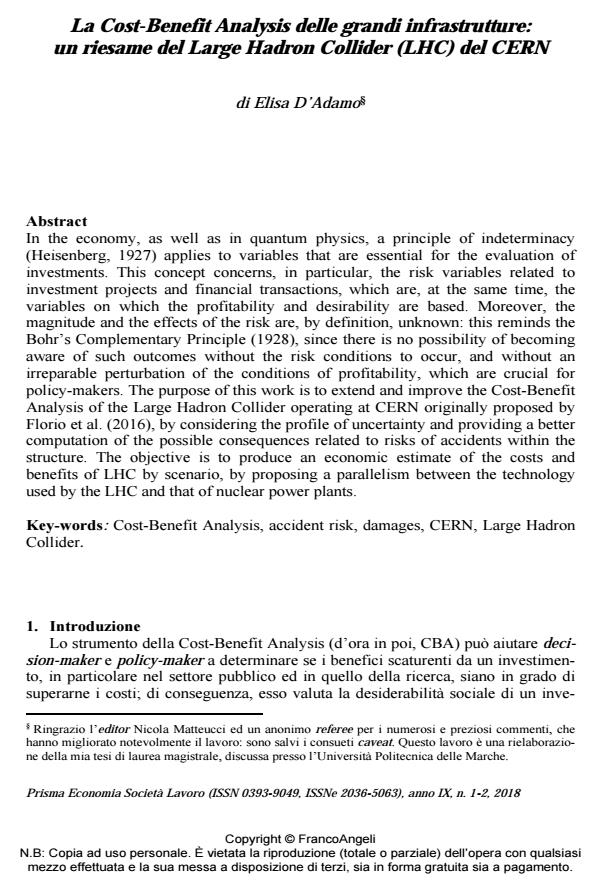La Cost-Benefit Analysis delle grandi infrastrutture: un riesame del Large Hadron Collider (LHC) del CERN
Titolo Rivista PRISMA Economia - Società - Lavoro
Autori/Curatori Elisa D’Adamo
Anno di pubblicazione 2019 Fascicolo 2018/1-2
Lingua Italiano Numero pagine 12 P. 97-108 Dimensione file 264 KB
DOI 10.3280/PRI2018-001007
Il DOI è il codice a barre della proprietà intellettuale: per saperne di più
clicca qui
Qui sotto puoi vedere in anteprima la prima pagina di questo articolo.
Se questo articolo ti interessa, lo puoi acquistare (e scaricare in formato pdf) seguendo le facili indicazioni per acquistare il download credit. Acquista Download Credits per scaricare questo Articolo in formato PDF

FrancoAngeli è membro della Publishers International Linking Association, Inc (PILA)associazione indipendente e non profit per facilitare (attraverso i servizi tecnologici implementati da CrossRef.org) l’accesso degli studiosi ai contenuti digitali nelle pubblicazioni professionali e scientifiche
In the economy, as well as in quantum physics, a principle of indeterminacy (Heisenberg, 1927) applies to variables that are essential for the evaluation of investments. This concept concerns, in particular, the risk variables related to investment projects and financial transactions, which are, at the same time, the variables on which the profitability and desirability are based. Moreover, the magnitude and the effects of the risk are, by definition, unknown: this reminds the Bohr’s Complementary Principle (1928), since there is no possibility of becoming aware of such outcomes without the risk conditions to occur, and without an irreparable perturbation of the conditions of profitability, which are crucial for policy-makers. The purpose of this work is to extend and improve the Cost-Benefit Analysis of the Large Hadron Collider operating at CERN originally proposed by Florio et al. (2016), by considering the profile of uncertainty and providing a better computation of the possible consequences related to risks of accidents within the structure. The objective is to produce an economic estimate of the costs and benefits of LHC by scenario, by proposing a parallelism between the technology used by the LHC and that of nuclear power plants.
Parole chiave:Cost-Benefit Analysis, accident risk, damages, CERN, Large Hadron Collider
- Bohr N., (1928) “The quantum postulate and the recent development of Atomic Theory”, Nature, April, 121, 580-590
- Finance Committee of CERN, (2017) Final budget of the Organization for the sixty-fourth financial year 2018, Report No. CERN/FC/6008-CERN/3243
- European Commission, (2014) Guide to Cost-Benefit Analysis of Investment Projects. Economic appraisal tool for Cohesion Policy 2014-2020, Directorate General for Regional and Urban policy, Brussels
- Florio M., Forte S., Sirtori E., (2016) “Forecasting the socio-economic impact of the Large Hadron Collider: A cost-benefit analysis to 2025 and beyond”, Technological Forecasting and Social Change, 112, 38-53
- Florio M., Sirtori E., (2016) “Social benefits and costs of large scale research infrastructures”, Technological Forecasting and Social Change, 112, 65-78
- Florio M., Vignetti S., (2003). Cost-benefit analysis of infrastructure projects in an enlarged European Union: An incentive-oriented approach, Università degli Studi di Milano, DEPA – working paper n.13/2003
- Florio M., Vignetti S., (2013) The use of ex post cost-benefit analysis to assess the long-term effects of major infrastructure projects, Center for Industrial Studies – working paper n.02/2013. Milano
- Heisenberg W., (1927) “Multi body problem and resonance in quantum mechanics”, II, Z Phys, 41, 239
- Schopper H., (2016) “Some remarks concerning the cost/benefit analysis applied to LHC at CERN”, Technological Forecasting and Social Change, 112, 54-64
- Wheatley S., Sovacool B., Sornette D., (2015) “Of disasters and dragon kings: a statistical analysis of nuclear power incidents and accidents”, Risk analysis, 37(1), 99-115
- Williamson O. E., (2000) “The new institutional economics: taking stock, looking ahead”, Journal of economic literature, 38(3), 595-613
- Williamson O.E., (2014) “Interdisciplinary Social Science: The Transaction Cost Economics Project”, in R.M. Solow, J. Murray (eds), Economics for the Curious, Palgrave Macmillan, London
Elisa D’Adamo, La Cost-Benefit Analysis delle grandi infrastrutture: un riesame del Large Hadron Collider (LHC) del CERN in "PRISMA Economia - Società - Lavoro" 1-2/2018, pp 97-108, DOI: 10.3280/PRI2018-001007